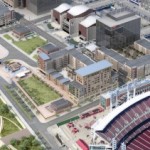Hamilton County leaders announced last Thursday that they had struck a deal with the Cincinnati Bengals regarding a number of issues pertaining to the county’s stadium contract with the team.
The biggest component of that new agreement is that the Bengals will waive their veto right over the heights of buildings at The Banks. This clause in the stadium deal, signed in 1997, delayed the start of construction of Phase IIA work at The Banks by more than a year, and posed a significant risk to the City of Cincinnati in its efforts to lure General Electric and its new Global Operations Center to the central riverfront.
Now that the agreement is signed, developers of The Banks have announced that they will immediately begin construction on Phase IIA project that will include 291 apartments and 19,000 square feet of retail space.
Should the city succeed in its efforts to land General Electric’s facility at The Banks, it is expected that its new office tower would either be located at the office pad within the Phase I footprint, or more likely on top of the street-level retail adjacent to the apartment midrise at Phase IIA.
The development team believes both sites could accommodate the approximately 400,000 square feet of office space desired by General Electric.
The announcement also brought with it renewed questions about the status of the hotel at Phase I, located immediately across the street from Great American Ball Park. On that note, the developers said that they are still working to sign a hotel operator for the space, and that it is unlikely it will be completed ahead of the 2015 MLB All-Star Game.
That leaves only one element of Phase I of The Banks still in question – the oft-forgotten townhomes lining the Schmidlapp Event Lawn.
When asked about the status of the townhomes, and if their delay in moving forward was related to constructability issues with the adjacent and unbuilt hotel site, Libby Korosec, spokeswoman for The Banks development team, said that there are no longer plans for townhomes at that location.
Korosec went on to say that the future of that particular site has yet to be determined, but that it is possible it could be used as part of the hotel, but that no decisions have been made.
“That site was originally planned to have six to eight townhomes, which is not really an efficient number to go in and build,” Korosec explained. “Not only was it not efficient, but it also wasn’t going to be a very good environment for townhomes with all the in and out traffic nearby.”
Korosec noted that the elimination of townhomes from the Phase I footprint does not mean that townhomes will not be built elsewhere. In fact, she said that the development team believes there are other sites at The Banks that would be better suited for such housing.
Part of the change can also be explained by the housing bubble that burst around the time construction started at the site.
“The market on condos and townhomes turned south just when we signed the MDA,” Korosec said. “However, homeownership via condos is still a strong possibility at The Banks for future phases should the market demand it.”
The development team opted to forgo building condos at $91 million Phase IA of The Banks, and instead built apartments due to the housing downturn. The decision has proved successful as apartments at The Banks fetch some of the highest prices per square foot in the region and have a waiting list of approximately 60 people.
Since that time the MDA was signed, however, the owner-occupied housing market has shown signs of life throughout the center city where there is currently little supply available. Recent developments, led by 3CDC in Over-the-Rhine, have sold quickly and, in some cases, for more than $300 per square foot.
The Banks development has drawn a significant amount of publicity since its first phase opened in 2011, but work is far from over at the massive riverfront project site. As of now, The Banks is only approximately one-third of the way built out.



